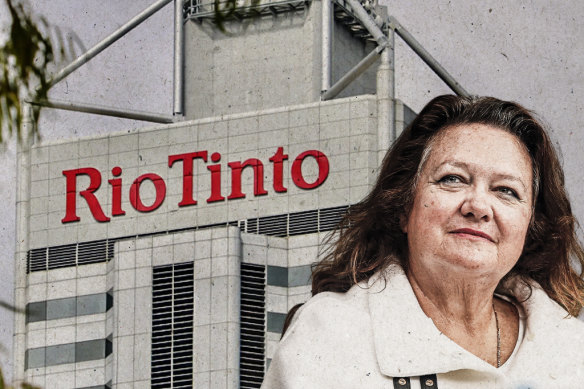Letters exchanged between Gina Rinehart’s Hancock Prospecting and resources giant Rio Tinto ahead of a 2005 deal to mine her father’s most lucrative iron ore prospect show the companies readied themselves for the possibility other parties may seek royalties, a West Australian court has heard.
The claim came on day four of a Supreme Court civil trial in which the descendants of mining mogul Peter Wright – the former business partner of Rinehart’s father Lang Hancock – are waging legal battle against Australia’s richest person to claim half of the royalties from ore mined at Hope Downs.

Gina Rinehart is locked in a court battle with the descendants of her father’s business over royalties from a mining tenement in Western Australia’s iron-rich Pilbara region.Credit: Getty Images
Wright Prospecting claims the tenement, discovered by the school friends-turned-business partners and now home to four operational mines, was held jointly under a 1980s partnership deed.
The company’s lawyer, Julie Taylor, SC, spent Thursday poring over documents from the mid-1980s to 2005 which she said showed Rinehart was well aware of her company’s royalty obligations.
Those included a letter Lang penned to Rinehart in 1986, where he highlights the sale of the valuable iron ore projects would hinge on the Wrights’ consent, and a letter from Rinehart to Wright’s daughter Angela Bennett, which stated royalties from Hope Downs would be split 50/50.
Also tendered was a letter between Rinehart and a senior director at a Hancock Prospecting subsidiary that discussed a royalty potentially owing to the Wrights after tenements were returned following their confiscation by the WA government.
More recent documents showed that issue was also flagged in the days before Hancock Prospecting inked a joint venture deal with Rio Tinto to mine the discovery in 2005.
Rapid fire emails exchanged as the June 30 deal deadline drew closer showed the companies discussed the possibility the Wright family and Don Rhodes, a fellow Pilbara prospector, may claim a royalty on the proceeds from their joint venture.
The court was told the deed signed before the joint venture’s announcement on July 1, 2005, incorporated rules for how that “liability” was to be met, with Hancock and Rio Tinto assuming joint responsibility.
Taylor said Hancock Prospecting’s knowledge of its royalty obligations was also noted in a feasibility study done for the Hope Downs 4 mine.
She argued there was “compelling” evidence Rinehart and several high-ranking, long-serving directors of her company and its subsidiaries knew they were liable to share Hope Downs’ proceeds with the Wrights.
Taylor also rejected the Hancock claim that it had taken on significant risks in developing the mine, including outlaying millions of dollars.
Hancock Prospecting and its executive chair Rinehart maintain the Hope Downs assets and royalties belong to them, insisting they put in the work to recover them and invest in their development after they were confiscated by the state government.
They have not had an opportunity to respond to the submissions.
Today’s submissions to the court follow the tendering on Tuesday of a 37-year-old letter from Lang Hancock to Gina Rinehart in 1986 which explicitly stated Hope Downs was an asset held by the partnership and should be shared.
The estate of Don Rhodes and Rinehart’s children are also seeking a share of the Hancock royalties in the civil case, which is expected to run for several months.
The case continues.
The Morning Edition newsletter is our guide to the day’s most important and interesting stories, analysis and insights. Sign up here.